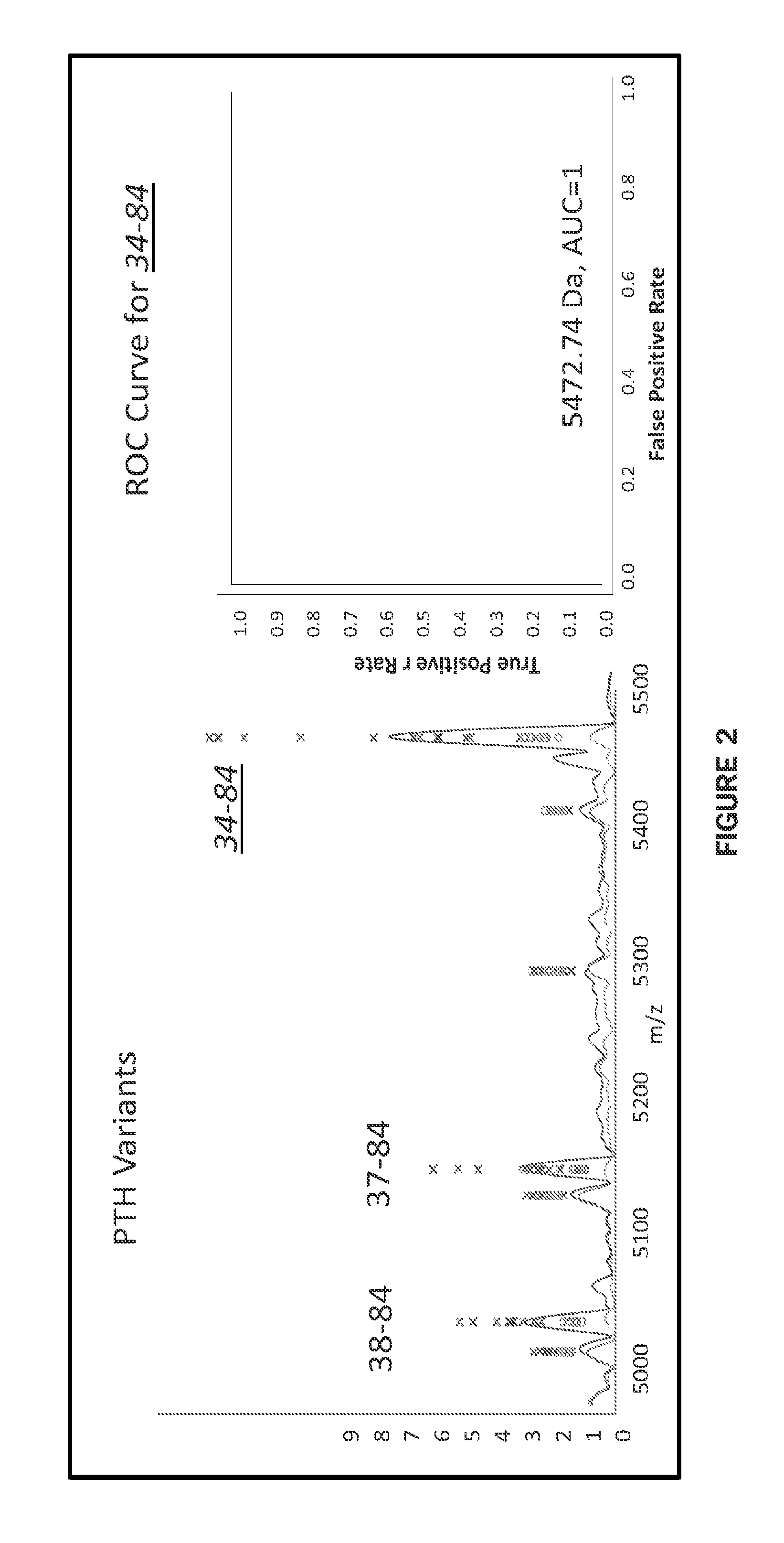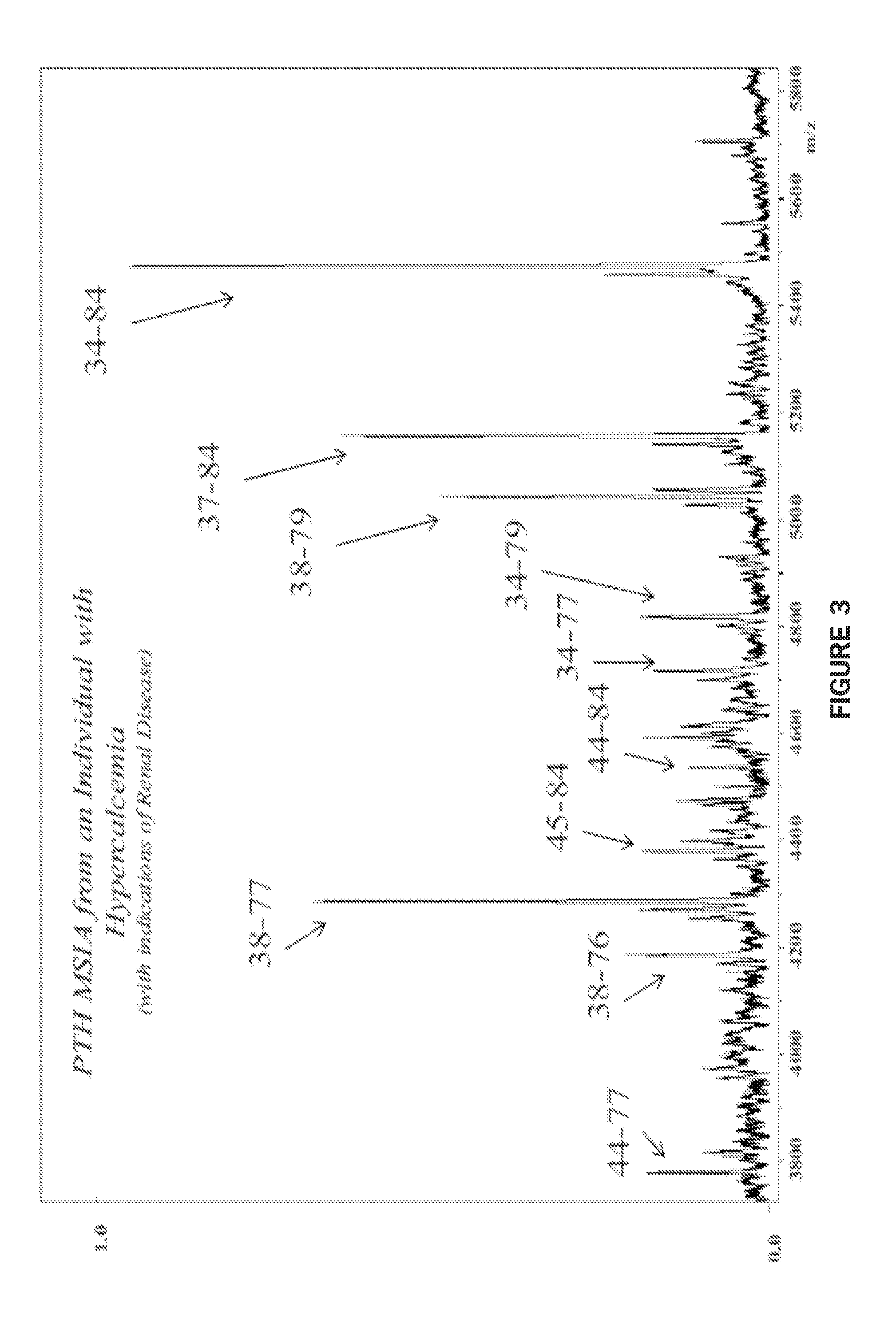Parathyroid hormone variants and assays related to disease
a technology of parathyroid hormone and variants, applied in the field of parathyroid hormone variants and assays related to disease, can solve the problems of ambiguity in the exact molecular species under investigation, unsatisfactory characterization of clinical utility and/or confounding effects, and greater microheterogeneity of pth
- Summary
- Abstract
- Description
- Claims
- Application Information
AI Technical Summary
Benefits of technology
Problems solved by technology
Method used
Image
Examples
example 1
Materials and Methods
[0088]Approach: As a starting point for the development of the PTH MSIA, we surveyed the literature to define molecular variants that have already been identified. In addition to the well-characterized truncated variants (e.g., PTH1-84 and 7-84), four other molecular versions have been reported in the literature as present in human biofluids (primarily plasma or serum). Aligning these fragments to the sequence of PTH1-84 produced a variant map revealing forms stemming predominantly from N-terminal truncations (FIG. 1A). A conserved region (among several variants) was evident between residues 48-84. This region was suitable for immunoaffinity targeting in order to capture ragged N-terminal variants (e.g., PTH1-84 and PTH7-84). A full-scan MSIA (MALDI-TOF-MS) (18-23) captured these variants, and also presented the opportunity to discover other variants immunoreactive with the antibody (FIG. 1B). Reagents: Goat polyclonal Anti PTH39-84 antibody was purchased from I...
example 2
Results
[0091]Top-Down Analysis and Discovery of Novel Variants. The approach described herein couples targeting a common region of PTH using a polyclonal antibody (raised to the C-terminal end of the protein) with subsequent identification using mass spectrometry (either MALDI-TOF-MS or SRM). Using a top-down approach (MALDI-TOF-MS), novel truncated PTH variants were discovered in clinical samples (FIG. 1). FIG. 1, Bottom panel shows two MSIA (MALDI-TOF-MS) spectra representative of those obtained from plasma samples of 12 individuals suffering from renal failure and 12 healthy controls. Signals corresponding to the previously reported N-terminally truncated variants as well as additional signals aligning with other novel variants are indicated. Notably, a conserved cleavage site (residue 77) was observed in several of these new variants (FIG. 1B). With the exception of PTH7-84, the variants depicted in FIGS. 1A and B were detected in the majority of clinical samples, and not readil...
example 3
[0092]FIG. 3 presents a MALDI-TOF-MS spectrum from an individual known to have hypercalcemia (with indications of renal disease). The results confirm the PTH heterogeneity signature seen in Example 2, and demonstrate an additional variant that may be linked to hypercalcemia: PTH (44-77). As more disease states are scrutinized in more detail, it is expected that more unique PTH fragments will become evident and new disease-specific protein profiles will be established.
[0093]As demonstrated in the top-down analysis described above, a single, high-affinity polyclonal antibody was able to simultaneously extract numerous PTH variants and the selection of the epitope was directed by the desired assay target (ie intact and N-terminal variants). In the case presented here, our primary goal was to differentiate between intact PTH1-84 and N-terminal variant PTH7-84, while simultaneously identifying any additional N-terminal heterogeneity throughout the molecule. The results of these top-down ...
PUM
| Property | Measurement | Unit |
|---|---|---|
| concentrations | aaaaa | aaaaa |
| body weight | aaaaa | aaaaa |
| volume | aaaaa | aaaaa |
Abstract
Description
Claims
Application Information
 Login to View More
Login to View More - R&D
- Intellectual Property
- Life Sciences
- Materials
- Tech Scout
- Unparalleled Data Quality
- Higher Quality Content
- 60% Fewer Hallucinations
Browse by: Latest US Patents, China's latest patents, Technical Efficacy Thesaurus, Application Domain, Technology Topic, Popular Technical Reports.
© 2025 PatSnap. All rights reserved.Legal|Privacy policy|Modern Slavery Act Transparency Statement|Sitemap|About US| Contact US: help@patsnap.com



